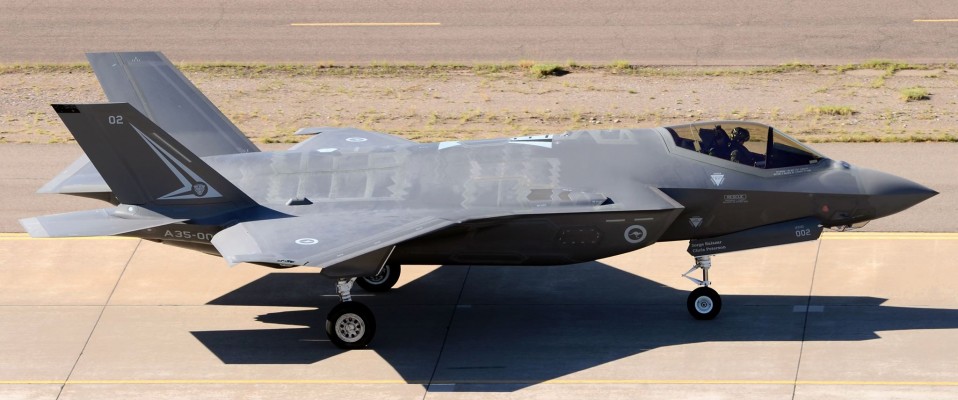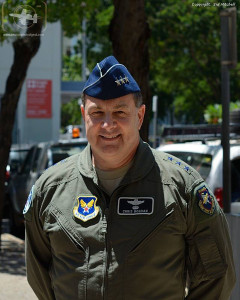Lead image: A RAAF F-35A (A35-002) taxis past the control tower at Luke AFB. Photo credit: Jonathan Navarro
Lightning Strikes Back!
Article by: Sid Mitchell and Jaryd Stock
Photos by: Sid Mitchell, Jonathan Navarro and Steven Valinski
March 18, 2016
On Sunday the 21st of February in Darwin, Australia, United States Air Force Lieutenant General (Lt.Gen) Christopher Bogdan briefed the Australian and International media on the progress of the F-35 lightning II program and also was in the country to brief the Royal Australian Air Force on the progress of the 72 F-35A aircraft they plan on operating out of RAAF Bases Williamtown and Tindal.
The Lt.Gen was in Australia on official business to do a few things, as he stated, when he was explaining why he was in Australia, “I am here for three reasons, those being to meet and provide updates to the Australian Department of Defence and Royal Australian Air Force officials on my assessment, both good and bad, on the F-35 program. Also, visit RAAF Base Tindal and provide information as required and also see how the base is progressing (Tindal is planned to house 16 out of the 72 F-35A’s the Australian Government have ordered receiving them in 2022). And, I am also here to appear at the Senate Hearing discussions where Question and Answers will be delivered to members of the Australian Government, based on the F-35 acquisition for the RAAF.”
He states there are many misconceptions about the JSF project ranging from various ideas. Several factors have driven these misconceptions as the LtGen mentions:
“Well, in the beginning it had a tragic past. All new projects have early hurdles to jump that is just a natural process. It’s also is a big project, the scope and scale of which is something that has never been seen before in the defence aviation industry. There are 14 customers integrated into the program including 3 FMS (Foreign Military Sales) customers. But the program is growing, accelerating and improving.”
“Production delivery from Lockheed Martin was 45 units in 2015, the next 2 years we will see 100 airframes. In four years, there will be 140…that is triple the current production rate. Total builds between the fiscal years of 2016 and 2022, are around 873 units”.
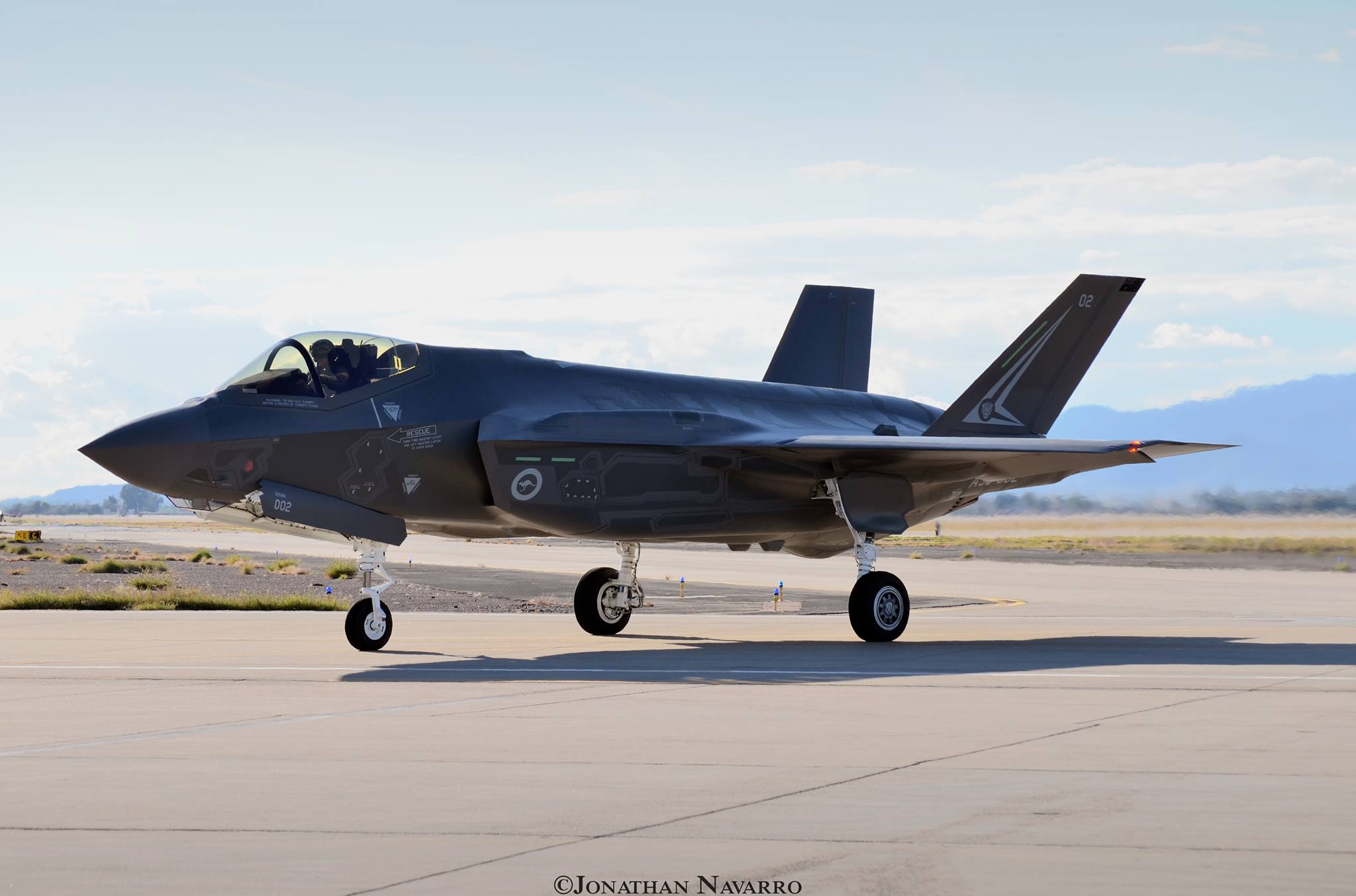
One of two RAAF F-35As arrives at Luke AFB. Photo credit: Jonathan Navarro
Recent Milestones
The F-35 project has gained slight momentum of late with the fleet of F-35’s including the Alpha, Beta and Charlie models passing the 50,000 flight hour mark this month (February 2016). The first flight hour was achieved by an F-35B aircraft, BF-1, June 11, 2008. The 25,000 flight hour milestone occurred in December 2014, six years and six months later.
As a sign of program growth and maturity, the second 25,000 flight hours were reached only one year and two months later.
Some milestones recently were the completion of some trials for the United States Marines and United States Navy variants of the F-35.
For the US Navy they achieved 100% carrier landings (TRAP) on the USS Dwight D. Eisenhower which coincidentally has never before been heard of for a new aircraft conducting TRAPS on a carrier. For the Marines – the United States Marine Corps declaring initial operational capability (IOC) in 2015 is a major milestone.
Other F-35 Mission System milestones that the Lt.Gen briefly informed the media on were:
- Completed seven Weapon Delivery Accuracy (WDA) events
- Completed air-to-surface and air-to-air Infrared Counter Measure testing
- Completed first Foreign Military Sales AIM-120 Live Fire
- Completed Block 2B flight testing for 2B fleet release and USMC Initial Operational
Capability
- Performed Gen III Helmet Mounted Display testing, including night, formation, aerial refuelling, and approaches
F-35A
- Completed F-35A 3F high angle of attack and performance testing
- Completed aerial refuelling certification for the F-35 with the Australian tanker (KC-30A from
33SQN) and Italian tanker (KC-767) testing, including night operations
- Performed 13 weapons separations in 2015; completed GBU-31 and GBU-39 weapons separations
- Accomplished the first aerial gun fire – qualified
F-35B
- Completed F-35B 3F flutter testing
- Completed F-35B 3F External Air to Ground Loads testing
- Accomplished eight weapon separations, including the first Paveway IV safe separation
- Accomplished the first ski jump
F-35C
- Completed F-35C DT-II Ship Trials aboard the USS Dwight D. Eisenhower (CVN-69) 100%
trap rate.
- Completed wet runway testing at Edwards AFB
- Completed F-35C 3F flutter and performance testing
- Accomplished five weapon separations, including the first external separation from an F-35C
This month marks the two-year anniversary of the F-35 at Luke AFB in Arizona USA.
Once the home of USAF’s F-16 Viper training, Luke AFB’s 56 Fighter Wing now has the duel mission of training F-16 and F-35 pilots from around the world.
Currently, pilots from Australia, Norway and Italy are training at Luke alongside USAF pilots, with countries such as Turkey, The Netherlands, Denmark, Japan, Korea and Israel training there in the future. Luke currently has 35 F-35s based there with 144 scheduled to be there by 2024.
Since the F-35 arrived at Luke two years ago, 6,100 flight hours and 4,125 sorties have been flown.
Lt. Col. Matthew Hayden, 56th FW chief of safety, had this to say in a USAF interview: “Training fighter pilots has been the cornerstone of the Luke mission for years, and the transition to the F-35 enables us to utilize our expertise in training, airspace, ranges, weather and infrastructure of the West Valley and catapult the Air Force and our F-35 partner nations into the fifth generation strike platform training environment,” Hayden said. “At even the early stages of Luke’s F-35 training you can already see the far-reaching impact on the Air Force and the entire F-35 enterprise.”
Recently, another F-35A milestone was reached at Luke when the first weapons release by F-35s assigned to the 56th Fighter Wing took place at the Barry M. Goldwater Range in Arizona. Two aircraft assigned to the 62nd Fighter Squadron successfully employed four laser-guided bombs.
“Yesterday we were able to execute one of the primary missions of this multi-role fighter and successfully employ air to ground weapons,” said Lt. Col. Gregory Frana, 62nd Fighter Squadron commander. “As we execute the mission of training the world’s greatest F-35 pilots it is critical we make our training as realistic as possible.”
As the F-35A continues to make progress towards reaching Initial Operational Capability (IOC), this weapons release follows the Feb. 25 employment of laser-guided bombs by combat-coded F-35As from the 388th Fighter Wing at Hill AFB, Utah, and the March 3 employment from the 33rd Fighter Wing at Eglin AFB, Florida.
In talking about the significant milestone of achieving 50,000 flight hours Lt.Gen Bogdan said: “The F-35 program continues to grow and accelerate as we complete additional flight testing and increase deliveries to our U.S. and partner war-fighters. The next 50,000 hours will be achieved much quicker as we double the size of the F-35 fleet worldwide in the next three years alone.” The Flight hours are divided into two main categories: Operational flying hours, flown by 155 jets delivered to six different nations, and System Development and Demonstration (SDD) flight test hours, flown by 18 aircraft assigned to the Integrated Test Forces at Edwards Air Force Base in California, and Naval Air Station Pax River. Of the 50,000 hours, operational jets flew approximately 37,950 hours while SDD aircraft flew 12,050 hours. More than one third of the program’s flight hours were flown in 2015 alone. Among the three variants, approximately 26,000 hours were flown by the F-35A, 18,000 hours by the F-35B and 6,000 by the F-35C.
The Lieutenant General also stated that “When the next 50,000 flight hours will be achieved obviously the program continues to mature and grow, we also increase deliveries to our allies as I stated, so as an example the next two F-35’s (A35-003/004) for the Royal Australian Airforce are scheduled to be delivered in 2018 to Luke AFB in Phoenix Arizona. We also have RAAF crews join the two Australian Instructors at Luke AFB ready to begin flying the F-35 later this year”.
Currently there are 17 operational bases globally mostly in the United States, and in addition to the manufacturing facility at Fort Worth, there are the Final Assembly and Check Out (FACO) facilities in Cameri, Italy, and another in Nagoya, Japan where the first jet is currently being manufactured. Down the track there is planned to be maintenance hubs situated and located outside of the United States these will most likely be in the Western Pacific and European regions, these hubs will be responsible for the maintenance so that regional users of the F-35 do not have to return their aircraft to continental United States for depot level maintenance. Lt.Gen Bogdan also went on to say, “The exciting news is that the Joint Strike Fighter Program Office would like to assign Australia to be considered as the hub for the airframe and engine depot level maintenance in the Western Pacific region”.
Money Money Money
During Lt.Gen Bogdan’s time he has seen a continual real dollar cost of production fall 3-4% at each lot in production. Currently from about $108M USD down to $100m USD and the Lt.Gen wants that to fall even further to what equates to approximately $80-85mil USD per unit by 2019, the same price it would be to buy a 4th Generation fighter.
He states that Lifecycle costs operating, maintenance and spares, has decreased between 9-10% in 4 years, and is significant saving. Include that with the aircraft type lifespan, “We are looking at the F-35 being operated for the next 50 years, the last airframe off the production line would be about 2030 and with an expected life of 20 years, that takes it out to 2050 or beyond. Typically a fighter aircraft has about 7/8000 hour lifespan, about 250 flying hours per year on average. The F-35 has 8000 hour expected lifespan, and testing that normally takes place on a new design when the airframe is placed in the “rig”, simulates double the life, that is 16000hrs. Lockheed Martin has now simulated 3 times that of the typical F-35 lifecycle from 8000 hours to 24000 and this is a first for any aircraft design. With operational costs of the F-35 expected to be 10-15% above current typical operating costs of say, the F/A-18”. Lt Gen Bogdan said.
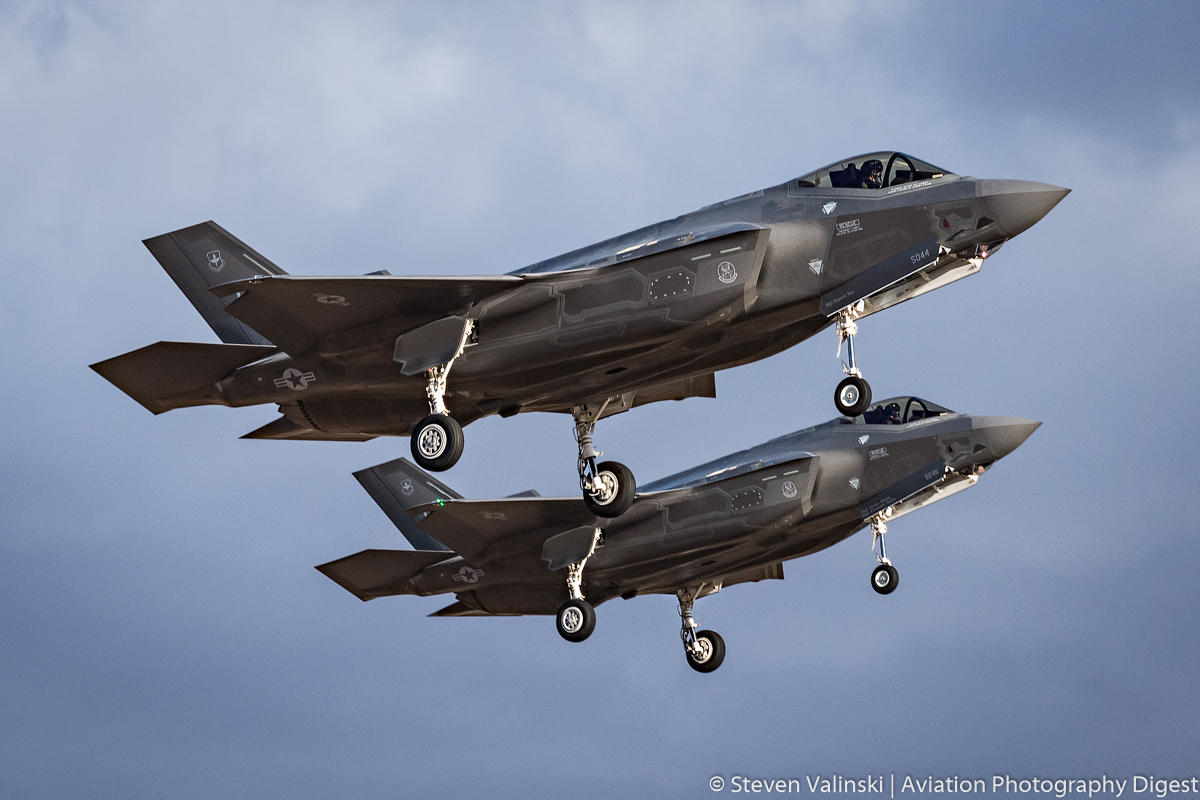
A pair of F-35A’s arrive back to Luke AFB after a training mission
Myth Busters
The many myths that surround the F-35, supported by people who one could say do not have exclusive access to the aircraft, were brought up by the Lt.Gen. “One area that is currently being improved, is the ALIS maintenance system (ALIS is the Autonomic Logistics Information System that gives the F-35 operators the ability to plan ahead, to maintain, to plan and sustain its systems over the life of the aircraft. ALIS provides the IT backbone and capabilities to support the crew of the F-35). It has been troublesome but advances and fixes are in progress and Lockheed Martin feel they can overcome these issues rather quickly… it is just one of many issues faced, and solved, when building the most advanced multi role fight in the world”. Lt.Gen Bogdan briefed us on some of the myths brought up by those opposed to the F-35 program and his candid response is as follows:
F-35 doesn’t like lightning.
“NO aircraft likes lightning period”! The issue was reportedly to be a high air/fuel ratio in the fuel tanks as not enough nitrogen was pumped in to displace oxygen in the fuel cells. We found the N2 pump was undersized. Solution to that was simple install a larger pump and problem was solved. This was the ONLY issue around lightning strikes. And I might add the aircraft has had actual lightning strikes in flight already – on the port wing tip in through the top and out the bottom leaving a small hole, an issue? No!”
Hot fuel.
“No engine likes fuel above a certain temperature and with regards to the avionics cooling issue, hence issue is resolved”.
F-35 needs to be stored in an air-conditioned building.
“No they do not need to be, the only reason they are parked in shaded areas/ carports is for maintainers comfort out of the direct sun especially appreciated in Phoenix, and also snow/rain. The aircraft are currently used at Eglin AFB in Florida, a sub-tropical region with days reaching 37 deg Celsius in summer and high humidity at times also”.
There was a problem reported with the helmet vision and stitching.
“That was with the old helmet design – what was happening was the pilot would turn his head quickly to one side and the images projected onto his visor would delay up to one second. This gave a ‘swimming” or ‘swishing’ effect as they caught up with his helmet movement. Quite disorientating. Also there was a ‘shimmering’ effect of the vision, like waves. ALL I repeat ALL of this has been rectified by the new Generation III helmet”.
F-35 cannot fly if it can’t connect to the internet.
“This issue is actually about the ALIS mentioned before. It is a maintenance system re-ordering and supply chain. If the internet goes down the immediate link from a maintainer (say replacing a part in the hangar, so then requiring a reorder at the operational base) is broken. This means the electronic link is broken from the maintainer to the base server- then to the country server and finally to the United States Lockheed Martin server. In most cases the part can be ordered manually, supplied from another squadron, base or even country. The aircraft CAN fly and quite often will mostly continue to fly beyond the normal order time for a part… this is why the base will hold a certain number of parts on hand as a contingency, another so called myth sorted”.
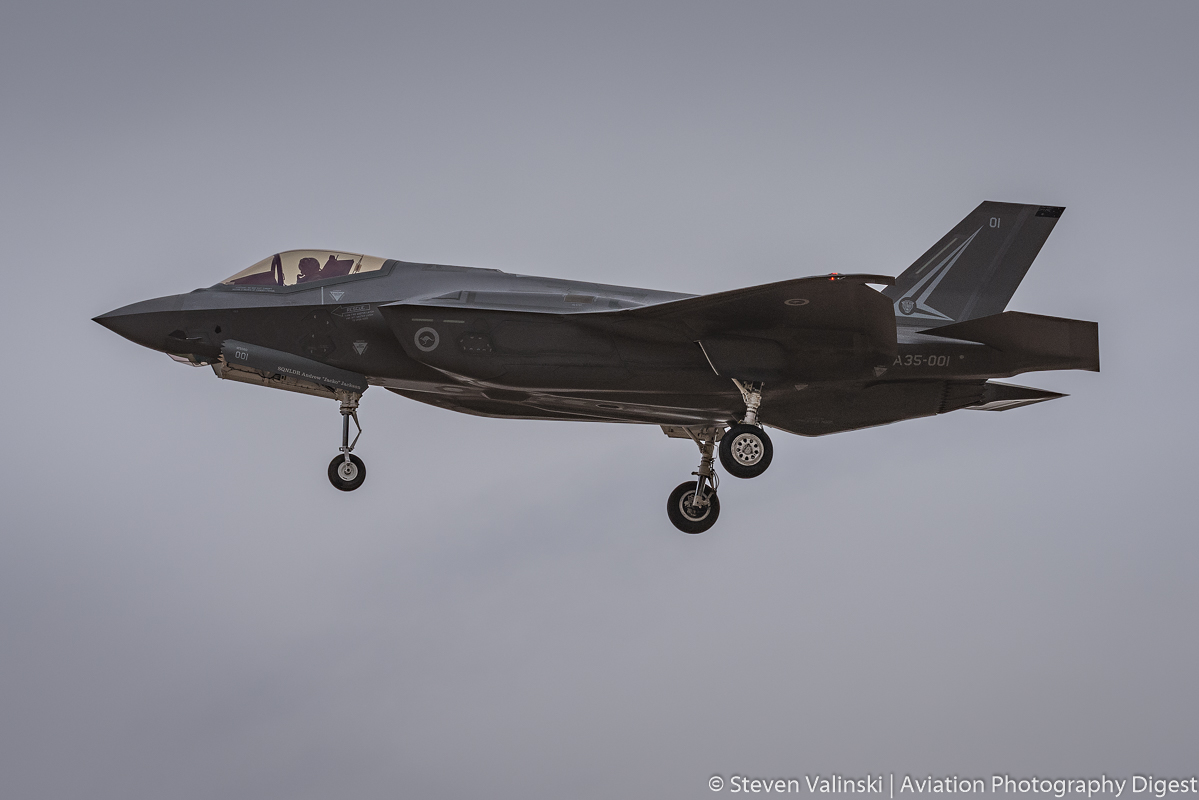
A RAAF F-35A arrives back at Luke AFB after a training sortie. Photo credit: Steven Valinski
The Lightning Storm Approaches
With over 3,000 aircraft ordered from the U.S. and its allied partners throughout the world it is easy to see where the future of modern aerial combat is heading. How does the F-35 stack up against its rivals? Lt.Gen Bogdan again reiterated. ”When matched configuration to configuration, i.e clean skin, or loaded with external stores, same fuel etc the F-35 will beat anything, Why?
Because of three main factors: Stealth capabilities, low observability, and I would just like to state NO aircraft is actually invisible not even the F-35, its Beyond Visual Range weapons launch capability, so the aircraft engages well outside normal combat ranges without being detected”. An example of this is the development of the Joint Strike Missile being developed between Australia and Norway, The Lt.Gen stated to APD that, “There is progress as the missile has done release checks from 22,000 feet. This missile is a ground or maritime strike missile developed by Kongsberg, we are interested to see this developed as an option for the F-35. It is an existing weapon that doesn’t need a lot of work and we would be interested to see it integrated well into the F-35 weapons system for our Australian and Norwegian partners”.
He goes on “Also Survivability, and what Lockheed Martin call Fusion which is the combination of a fully built in sensor package. The F-35’s advanced sensor fusion enables pilots to draw on information from all of their on-board sensors to create a single integrated picture of the battlefield. All of the information gathered is then automatically shared with other pilots and the command and control operating centre’s on their network in Ground based or AWE&C aircraft using the most modern datalinks.
These secure datalinks, such as the Multifunction Advanced Data Link (MADL), will enable pilots to share data with other strike aircraft as well as other airborne, surface and ground-based platforms required to perform assigned missions. The sensor package comes standard on the F-35, not a pod that is attached on pylons afterwards, or conformal fittings.. It’s all in the box off the production line. The ability to network/node not just between aircraft, but ground is extraordinary. For example say four F-35’s can give the ground commanders a big overall view of the battle space, while at the same time providing that information and picture to other theatre aircraft and even down to a small base or command post gives us something we could only have dreamed about 10 years ago and gives us an unrivalled view of the airspace and battlefield”.
“And with all these factors combined, and I say this as a person like I said who is not on any payroll of a aircraft or weapons manufacturer, but someone that is tasked to provide the very best combat platform to the United States Air Force and the allies of the United States, I know that nothing comes close to the F-35! ”.
Enough Said!
Jaryd Stock is based in Sydney Australia. He has been a die-hard aviation enthusiast from a young age when he was chauffeured around by his father to various airshows and airports around Australia. At his first Airshow he witnessed the awesomeness of a General Dynamics F-111C and immediately fell in love with aviation.
Jaryd picked up a camera at a young age and has never looked back. He now combines photography and writing to highlight “Downunder” aviation; especially U.S. DoD units. Jaryd uses Nikon cameras and lenses.


